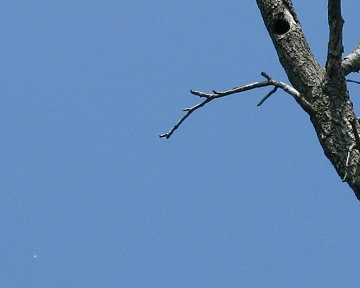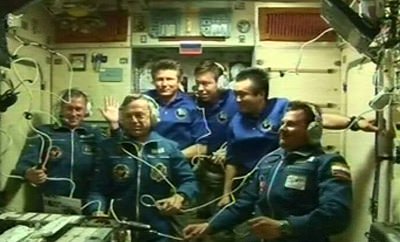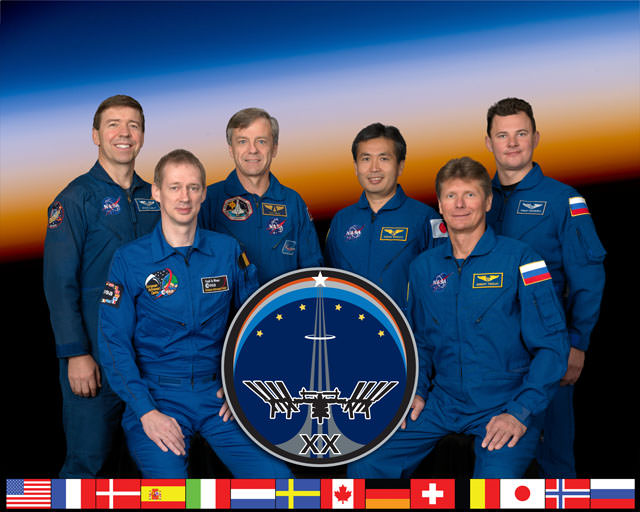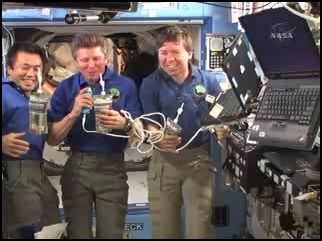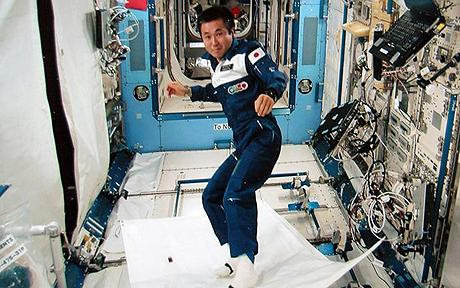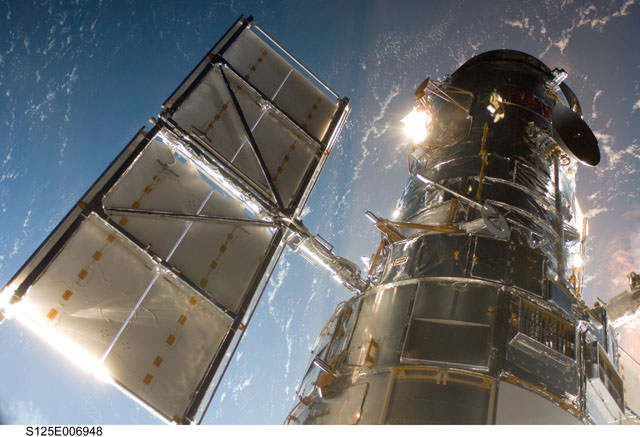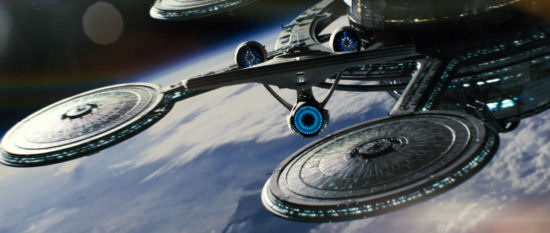[/caption]
Oh wow! I love satellite watching, and especially the International Space Station, but now I don’t have to wait for nightfall anymore. We reported that the ISS had become the second brightest object in the night sky back in March 2009 with the addition of the final set of solar arrays. And now its been confirmed that the space station, under the right conditions, can be visible during the day, too. “On June 13th, I was watching a red-headed woodpecker’s nest when the ISS passed overhead,” said Brooke O’Klatner of Charlotte, North Carolina, who took this image, which was posted on Spaceweather.com.
And the ISS will get even brighter when the STS-127 mission arrives, hopefully in July (liftoff has been re-scheduled for July 11 after being postponed today because of a hydrogen leak.) The mission will add an addition on to the Kibo lab, and with Endeavour attached to the station, it will be quite bright. Can’t wait! In the meantime, I’m going to test out my best eagle eyes and try to see the ISS during the day. If anyone is able to see it during a daytime pass, let us know! (Pictures encouraged!)
Company’s Coming! And They’re Bringing the Front Porch
[/caption]
UPDATE: 6/13
Endeavour’s launch has been postponed because of a leak associated with the gaseous hydrogen venting system outside the shuttle’s external fuel tank. The system is used to carry excess hydrogen safely away from the launch pad. Managers scrubbed the launch for at least 96 hours. The earliest the shuttle could be ready to launch is June 17. However, there is a conflict on the Eastern Range that date with the scheduled
launch of the Lunar Reconnaissance Orbiter/Lunar Crater Observation and Sensing Satellite. We’ll keep you posted on when a launch date is set.
Original article:
Space shuttle Endeavour is all set to blast off Saturday morning, June 13 at 7:17 am EDT, heading to the International Space Station. The mission will be jam-packed with five spacewalks for station construction, and Endeavour is bringing up a “front porch” for the ISS. Is adding a porch an attempt to make our orbiting home in space just a little more “homey?” Actually, the porch is a key piece of the Japanese laboratory, Kibo. And the ISS itself will be jam-packed, too as the newly expanded six-member ISS crew will welcome the seven-member shuttle crew – a record number of astronauts to be on board the station at one time.
On Friday morning the Rotating Service Structure was removed from around Endeavour, and all indications are good for an on-time liftoff Saturday. The weather looks to be about 90% “go,” and the shuttle processing has been smooth in preparations for launch.
“We’re in really good shape to fly,” said Mike Moses, director of shuttle integration at the Kennedy Space Center. “The team carefully reviewed the spacecraft to make sure nothing was overlooked since the launch comes only a few weeks after the end of the STS-125 Hubble repair mission.
Moses said having the big crew on the station could be an interesting time. “It’s like having your family descend on you for the holidays, right? And they’re going to stay for a very long time. And they come, and they’re bringing all their stuff.”
But he said the combined crews are more than ready for the challenge. “I think what we’re going to see is probably some unprecedented efficiencies because they all know where to go, they know what the procedures are, they know how to get things done,” he said.
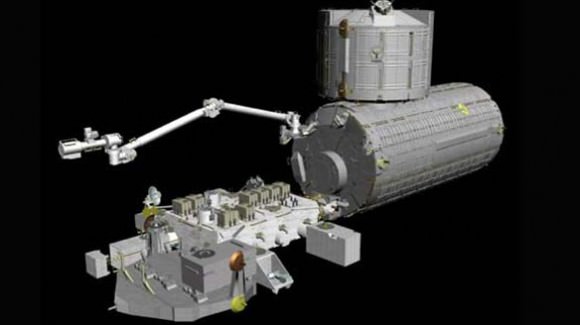
Endeavour’s crew will install the porch, which is actually a platform for one end of the Kibo laboratory on the station. The platform will hold experiments designed to work outside the protective confines of the station, exposing them to the space environment.
Mark Polansky (follow him on Twitter at Astro_127) will command the shuttle for STS-127. Douglas Hurley will serve as the pilot. Mission specialists are Christopher Cassidy, Thomas Marshburn, David Wolf and Julie Payette, a Canadian Space Agency astronaut.
Also flying along is Timothy Kopra, who will stay on at the ISS as a flight engineer and science officer, while current ISS resident and Japanese astronaut Koichi Wakata will return to Earth.
This will be a banner flight for all the international partners, as all five space agencies – the United States, the Russian, the Canadian, the Japanese and the European – will have representatives at the space station when the shuttle arrives, in addition to the six extra Americans and one extra Canadian Endeavour will carry. Polansky said just having all those nations represented and working together toward common goals is a huge accomplishment.
“I don’t think that, as a global community, we get the credit we should for doing something like that and what it means to set that kind of example,” he said. “Countries that have, historically, had a lot of differences and even today have some tensions, politically – when it comes to the arena of space, we’re somehow insulated from all that. On our level, it’s simply figuring out how to get the job done. And it’s not just a job like you’re constructing some building here on Earth. You’re doing something in an extremely hostile environment.”
The two crews will be extremely busy during the 16 day mission, so don’t expect to see them sitting back and relax on the front porch.
If you want to watch the launch preparations on NASA TV, the crew will strap into Endeavour about 4:00 am EDT on Saturday.
ISS Crew Expands; Now’s the Time To Expand Your Knowledge of the Orbiting Outpost
[/caption]
The crew of the International Space Station has now increased to six for the first time with the arrival of three new residents. Also, for the first time all the ISS partners are represented on board the station at once as astronauts from NASA, CSA, ESA, JAXA and Russia are all part of the crew. The Soyuz TMA-15 docked with the ISS at 12:34 UT, and the new crewmembers entered the station at 14:14 UT. “I sincerely appreciate the international partners’ continuous efforts to enable the 6-person crew on-board after having overcome so many challenge,” said Dr. Keiji Tachikawa, president of JAXA. I believe that an increased number of ISS crewmembers will make use of the ISS … capabilities to the utmost extent …and this contributes to the safe and steady operation of the ISS.”
Now that the science and all sorts of other activity will be ramping up on the space station, it’s a good time to get to know your ISS a little better. Here’s a few links that will help:
Very cool interactive ISS site, with talking astronauts! Take a 360 degree tour of the station and find out what it is like to live on board.
An interactive feature about the International cooperation.
Find out more about the science on board the ISS.
This very cool feature allows you to see images of Earth — as seen from space — from the current location of the space station. Note: not live pictures, but images taken earlier and when you visit the website, the telemetry is calculated to give you a picture from the station’s approximate location.
Find out when you can see the station flying over your backyard:
Heaven’s Above
NASA’s Real Data site
ESA’s “ISS – Where is it Now” site
Follow the latest ISS news from NASA.
If you are into video games: Space Station Sim
New Era for ISS Begins As Crew Size Doubles
[/caption]
Three astronauts set to launch on a Soyuz rocket will bring a new era to the International Space Station by doubling the permanent crew size. Also, for the first time all the ISS partners will be represented on board the station at once as astronauts from NASA, CSA, ESA, JAXA and Russia will be part of the first six-person permanent crew. Liftoff is scheduled for 4:34 p.m. local time (1034 GMT; 0634 EDT) Wednesday from Russia’s Baikonur cosmodrome in Kazakhstan. The Soyuz TMA-15 capsule is expected to dock with the space station about two days later.
On board the Soyuz will be a truly international contingent, with Canadian astronaut Bob Thirsk, Russian cosmonaut Roman Romanenko, and Belgium’s Frank De Winne. They will join the current crew of the orbiting laboratory: Russia’s Gennady Padalka, U.S. astronaut Michael Barratt and Japan’s Koichi Wakata.
Thirsk called the expansion from a three-person to a six-person crew a “milestone” and said one of their goals was “to prove the station can support six people for a long duration.”
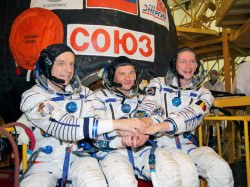
“This is the most international crew we’ve ever had” said Courtenay McMillan, Expedition 20 lead flight director. “It opens up a lot more possibilities and lets us schedule more science. We also have a lot more maintenance activities that can be done. Having six people on board does present a bit of challenge in communications with the ground, as we have twice as many people but no more ‘phone lines’, but folks are getting creative. We’ve learned a lot from the handover periods.”
A current crew of three typically has only about 20 hours a week to devote to science, but with six crew members, ISS officials hope to nearly triple the amount of time spent on science experiments. “This is a big transition from where we have been short on time. Now we have time,” said McMillan. “The crew has been very active in working with science community, ground control teams and to take advantage of the time we have.” McMillan added that the crew will have the ability to do not just new science, but doing additional runs on science that is up on board the station now.”
The last few shuttle missions to the ISS and Progress re-supply ships have been bringing up enough supplies to accommodate the increase in crew size. Now that the urine recycling system is working well, food is the biggest consumable the crews have had to stockpile.
“We have good margins on consumables,” said McMillan. ” We’ve piled up more margin than we usually do, to protect against flight slips. NASA said there is enough supplies on board that the crew could have enough to eat though October, even if no shuttles or Russian ships made it to the station. However two shuttle missions and two Soyuz capsules are scheduled to arrive at the station before the end of October.
SRB Videos, A Toast to Recycled Urine and Other Misc. Spaceflight Notes
It has been a busy day in space and here are a few jottings about what all has been going on. Above, you can watch the spectacular videos taken by cameras mounted on the shuttle’s solid rocket boosters, taken during the launch of Atlantis on the current Hubble Servicing Mission. It’s a crazy ride, tagging along on the outside of the shuttle going up, and spinning dizzily on the way down until splashing in the ocean. Not for the faint of heart! But seeing the SRB videos means only one thing: Atlantis and the STS-125 crew have been cleared to land. NASA has carefully reviewed the videos and the data from the crew’s scan of the shuttle’s thermal protection system, saying there are absolutely no issues that would preclude the shuttle from landing. Weather, however could be another matter, which is why NASA ordered the shuttle to power down for awhile today to save on consumables. Predicted weather does not look good for landing on Friday, so the crew will make sure they have enough power to stay in orbit for a few more days.
Now about that toast…
[/caption]
A huge crowd gathered in the space station mission control room at Johnson Space Center today as the ISS crew was given a “go” to drink water that the new recycling system has purified. Everyone joined in at mission control with a toast to the success of the recycling system, giving a nod to everyone who helped create the system, install it on the ISS and work on getting the fussy system to run. This is big news, as it means the station is ready to handle the increased crew size of 6 astronauts.
Also:
The STS-125 crew held a press conference from the shuttle today. The highlight was Mike Massimino talking about how he ripped a handrail off of Hubble in order to proceed with the scheduled repair of the STIS instrument.
“Ripping that thing out of there was quite an experience, and I’m glad it led to a successful repair,” said Massimino, who added that he drew inspiration from his uncle Frank, who once ripped an oil filter out a car. “That was pretty close to what was going on with Hubble.”
Later, during a ship-to-ship call between Atlantis and the ISS, space station crew member Michael Barrett revisited Massimino’s special touch.
“The magic Massimino touch is now legendary, and we’re looking forward to seeing you guys back on the ground,” he said.
If you missed the crew news conference, its available here. Additionally, the discussion between the two crews, can be seen here.
Update: One other piece of news from the shuttle is that President Obama called the STS-125 crew to congratulate them on a job well done. “I wanted to personally tell you how proud I am of all of you and everything that you’ve accomplished,” he said.
“Like a lot of Americans, I’ve been watching with amazement the gorgeous images you’ve been sending back and the incredible repair mission you’ve been making in space,” he said. “I think you’re providing a wonderful example of the kind of dedication and commitment to exploration that represents America and the space program generally. These are traits that have always made this country strong and all of you personify them.”
Obama also said he would be naming a new NASA administrator very soon, but wouldn’t say who it is.
“Just so we’re sure, the new administrator is not any of us on the flight deck right now, is it?” asked Commander Scott Altman (Altman had suggested Hubble fix-it man John Grunsfeld for administrator earlier this week.)
“I’m not going to give you any hints,” Obama said with a laugh.
“Thank you very much, fair enough, sir,” Altman replied.
Listen to the audio and/or read the transcript of Obama’s call here.
One other spaceflight news tidbit, Orbital Sciences Corp. finally launched a Minotaur 1 rocket from the Wallops Island Flight Facility with the Tactical Satellite-3 (TacSat-3) satellite. The launch was heavily postponed, with several scrubs relating from the weather to the launch vehicle and facility. Find out more about the launch and the satellite here.
Flying Carpets in Space: Yes. Folding Laundry: No
[/caption]
Astronauts in orbit have said it time and time again: some things are easier in the microgravity environment in space, other things are harder. Japanese astronaut Koichi Wakata, current resident of the International Space Station recently gave a video demonstration of a few odd tasks in space, showing how simple, everyday jobs here on Earth, such as folding laundry and using eye drops, can become difficult in space. But he also proved how one “impossible” action for us landlubbers is fairly simple to do on board the ISS. He soared on a magic carpet.
Wakata filmed 16 different tasks in space as part of a series of zero-gravity challenges submitted by the public.
Albeit, he couldn’t use just any carpet; it had to be magic. Or in this case, a carpet with a little rigidity worked the best, and he had one more secret to his success: adhesive tape (not sure if it was duct tape). Here’s the video clip of posted by the Japan Aerospace Exploration Agency (Jaxa).
Wakata is shown gliding smoothly, after a fashion, through a cabin of the International Space Station, as if snowboarding.
“I flew on this magic carpet by using adhesive tape so that the soles of my feet stayed on it,” the 45-year-old astronaut said. The tasks were selected from ideas sent to the space agency by hundreds of members of the Japanese public, from nursery school pupils to a 90-year-old man. Wakata performed the tasks in the Japanese laboratory Kibo (Hope) of the ISS on May 15. He also filmed a series of other tasks in April, including push-ups.
He handled the awkward task of folding laundry in microgravity, struggling with a shirt and then, for added difficulty, the floating arms and legs of a blue space overall. Finally, a bungee cord was necessary to keep the uncooperative overall from unfolding.
Tackling another challenge, Wakata showed how to use eye drops in zero gravity, squeezing out a tiny ball of liquid and letting it perch at the tip of the container before carefully bringing it to his eye.
Source: The Telegraph
Hubble Servicing Mission 4 in Pictures, Part 1
[/caption]
The long-awaited Servicing Mission 4 for the Hubble Space Telescope has provided drama, nail-biting excitement, fist-pumping triumphs and ‘what else could go wrong now’ moments. But the best way to to describe the mission is to let the amazing images from the EVAs do the talking. Below are high-resolution images from NASA, highlighting the first three spacewalks.

The mission began with the picture-perfect, no-delay, long-awaited launch on May 11, 2009.
EVA #1

The first spacewalk of the mission, performed by astronauts John Grunsfeld and Drew Feustel lasted a little over 7 1/2 hours. They successfully installed the new Wide Field Camera 3 science instrument and a new Science Instrument Command and Data Handling Unit. Both WFC-3 and the SI C&DH passed their “aliveness” tests, which essentially means the devices powered on correctly. The WFC-3 also passed its functional test, meaning the capabilities of the instrument itself were tested. The SI C&DH unit has also received an initial OK on its functional test, pending final review of data sent down to the ground.
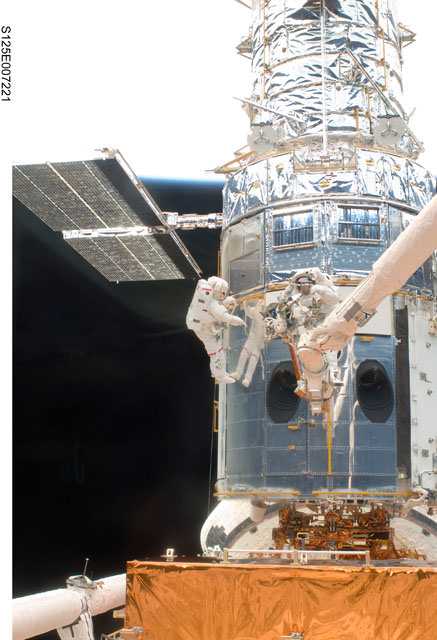
A stubborn bolt threatened to thwart one of the spacewalk’s main goals, replacing the venerable space telescope’s workhorse optical camera with a new and improved instrument. But after a fair amount of old fashioned elbow grease, the WFPC2 was able to be removed.

This close-up of Grunsfeld was taken by Drew Feustel, whose reflection is visible in Grunsfeld’s visor. Feustel is attached to the end of the shuttle Remote Manipulator System, or robotic arm. Grunsfeld was the free-floating astronaut for the EVA.

Here, Feustel, on the end of the shuttle’s robotic arm, carries the piano-sized WFPC3 to its new home inside Hubble.
EVA #2

The second EVA of the mission provided some challenges to astronauts Michael Good and Mike Massimino. However, they achieved all the objectives for this spacewalk, it just took them awhile — 7 hours and 56 minutes. They installed three Rate Sensor Units (RSUs), with a pair of gyros in each, and the first of two new battery module units.

Good and Massimino were not able to get one of the three prime RSUs into its slot but were able to install a spare, giving Hubble the new gyros it needed. The gyros are used to change the orientation of the telescope and keep it fixed on a particular astronomical target during observations.

The spacewalkers also removed one of the original battery modules from Bay 2 of the telescope and replaced it with a new unit. The batteries provide power to the telescope when Hubble passes into Earth’s shadow and its solar arrays are not exposed to the sun. Ground controllers at Goddard’s Space Telescope Operations Control Center confirmed that all six gyroscopes and the new battery passed preliminary tests.
EVA #3

The third EVA of the mission went like clockwork as Grunsfeld and Feustel teamed up again. They removed the Corrective Optics Space Telescope Axial Replacement and installed in its place the new Cosmic Origins Spectrograph. They also completed an unprecedented repair of the Advanced Camera for Surveys replacing an electronic card and installed a new electronics box and cable.

To do the repairs on ACS, Grunsfeld removed 32 screws from an access panel to replace the camera’s four circuit boards and install a new power supply. The two astronauts used specially designed tools to do a job that was never intended to be done on orbit. But they did it, and with efficiency.
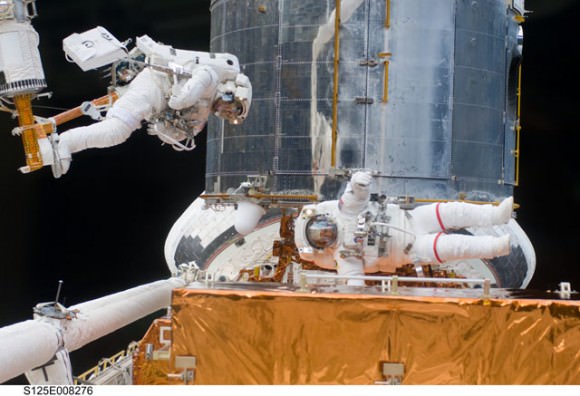
Engineers at Goddard have already performed “aliveness” tests on both COS and ACS to verify they have electrical power. However while a functional test of the ACS indicated success in reviving the instrument’s heavily used wide-field channel, officials said early Sunday that it appears the repairs failed to resolve power problem with the camera’s stricken high-resolution channel and it appears “down for the count.”
We’ll keep you posted on any developments with ACS, and provide more high-resolution images from the remainder of the mission soon!
For more images from the mission, or to download higher resolution versions of the pictures here, visit NASA’s Human Spaceflight gallery.
New Star Trek Movie Beamed Up to Space Station
[/caption]
In a convergence of science fiction and current technology, the new Star Trek movie has been “beamed up” to the International Space Station so the three occupants can watch it while orbiting 220 miles above Earth. Paramount sent a copy of the movie to NASA’s Mission Control, which then uplinked the movie to the International Space Station. The crew plans to watch the film on a laptop computer in the Unity module.
On board the station are NASA astronaut Michael Barratt, Russian cosmonaut and expedition commander Gennady Padalka, and astronaut Koichi Wakata from Japan.
“I remember watching the original Star Trek series and, like many of my NASA co-workers, was inspired by the idea of people from all nations coming together to explore space,” Barratt said in a statement provided by Paramount. “Star Trek blended adventure, discovery, intelligence and story telling that assumes a positive future for humanity. The International Space Station is a real step in that direction, with many nations sharing in an adventure the world can be proud of.”
Watching movies is one of the favored off-duty pastimes for ISS crews. There is a collection of DVDs and uplinked movies aboard the space station, some of which were delivered during previous shuttle and station missions and which will remain aboard for the enjoyment of future crews.
It’s not even the first time Star Trek has screened in space: Former station astronaut Greg Chamitoff and his crewmates viewed the entire Star Trek series as a regular weekly event.
Of course, if you want to see the new Star Trek movie, you don’t have to travel to the ISS; it’s now playing at movie theaters and IMAX screens. Check your local listings!
Source: SciFi Wire
Nancy Comes Out of the Closet on 365 Days of Astronomy
[/caption]
For Universe Today readers who know me only as a journalist, there’s something I’ve never revealed until today. But I tell all on today’s 365 Days of Astronomy podcast. The truth is, I’m a closet musician and songwriter. But while most musicians write songs about love, or love gone wrong, or that kinda stuff, being the space geek that I am, I write songs about things like, well, satellites, spacecraft and space missions. Today’s podcast is about the International Space Station, and I share a song I wrote after I saw the ISS for the first time in the night sky.
The first time I saw the ISS was back in December of 2000, just after the first set of large solar arrays were brought to the station. At that point, the ISS was then big enough and bright enough that I could finally see it in the light polluted skies over Minneapolis, where I lived at the time. But of course we had a couple of weeks of typical Minnesota winter cloudy weather, so I had to wait what seemed like an eternity until I could finally see it. But I’ll never forget how awe-inspiring it was to see that bright light moving quickly across the sky, knowing the Expedition 1 crew was on board that point of light.
So anyway, check out today’s 365 Days of Astronomy podcast. A friend of mine, Mike Spainhour, and I threw this recording together in about an hour, but I hope you enjoy it.
COLBERT on the ISS
[/caption]
2nd UPDATE: Watch the video of astronaut Suni Williams on “The Colbert Report” below .
There will be a COLBERT on the International Space Station. Word has it that NASA, however, did not name Node 3 on the ISS after comedian Stephen Colbert, who won a NASA-sponsored naming contest for the next module that will be brought to the station. According to Robert Pearlman on CollectSPACE, NASA will announce on Comedy Central’s “Colbert Report” later tonight (Tuesday) that the module’s name will be “Tranquility” – in deference to Apollo 11’s landing site on the Moon (40th anniversary and all this year). But NASA did name a new treadmill after Colbert, kinda sorta. NASA created an acronym for the treadmill as the Combined Operational Load Bearing External Resistance Treadmill, or COLBERT. Of course, this isn’t actually official yet. Pearlman’s article was published two hours before the “Colbert Report” aired (even though NASA’s press release specificially stated the name would “not be publicly released until the program airs.” Hmmm… guess nothing is sacred.) We’ll post the video and official word when available. You can see an image of the current treadmill on the ISS below.
UPDATE: Yes, it is true. Node 3 is Tranquility and the treadmill is C.O.L.B.E.R.T. The “official” treadmill patch is above, and the video from “The Colbert Report” is below. Colbert took it well, and he’s excited about the treadmill. Excerpts from NASA’s press release are below, as well.
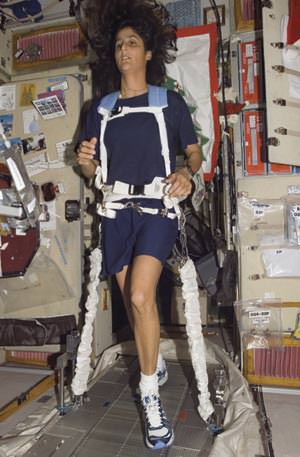
Here’s astronaut Suni Williams running on the current ISS treadmill. She ran a marathon in space on this treadmill.
Here’s info from NASA’s official press release on the new Node 3 name:
“The public did a fantastic job and surprised us with the quality and volume of the suggestions,” said Bill Gerstenmaier, associate administrator for Space Operations. “Apollo 11 landed on the moon at the Sea of Tranquility 40 years ago this July. We selected ‘Tranquility’ because it ties it to exploration and the moon and symbolizes the spirit of international cooperation embodied by the space station.”
“We don’t typically name U.S. space station hardware after living people and this is no exception,” Gerstenmaier joked. “However, NASA is naming its new space station treadmill the ‘Combined Operational
Load Bearing External Resistance Treadmill,’ or COLBERT. We have invited Stephen to Florida for the launch of COLBERT and to Houston to try out a version of the treadmill that astronauts train on.”
The treadmill is targeted to launch to the station in August. It will be installed in Tranquility after the node arrives at the station next year, scheduled for February 2010.

